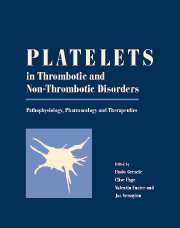Book contents
- Frontmatter
- Contents
- List of contributors
- Editors' preface
- PART I PHYSIOLOGY
- 1 History of platelets
- 2 Production of platelets
- 3 Morphology and ultrastructure of platelets
- 4 Platelet heterogeneity: physiology and pathological consequences
- 5 Platelet membrane proteins as adhesion receptors
- 6 Dynamics of the platelet cytoskeleton
- 7 Platelet organelles
- 8 Platelet receptors for thrombin
- 9 Platelet receptors: ADP
- 10 Platelet receptors: prostanoids
- 11 Platelet receptors: collagen
- 12 Platelet receptors: von Willebrand factor
- 13 Platelet receptors: fibrinogen
- 14 Platelet signalling: GTP-binding proteins
- 15 Platelet phospholipases A2
- 16 Roles of phospholipase C and phospholipase D in receptor-mediated platelet activation
- 17 Platelet signalling: calcium
- 18 Platelet signalling: protein kinase C
- 19 Platelet signalling: tyrosine kinases
- 20 Platelet signalling: cAMP and cGMP
- 21 Platelet adhesion
- 22 The platelet shape change
- 23 Aggregation
- 24 Amplification loops: release reaction
- 25 Amplification loops: thromboxane generation
- 26 Platelet procoagulant activities: the amplification loops between platelets and the plasmatic clotting system
- 27 Platelets and chemotaxis
- 28 Platelet–leukocyte interactions relevant to vascular damage and thrombosis
- 29 Vascular control of platelet function
- PART II METHODOLOGY
- PART III PATHOLOGY
- PART IV PHARMOLOGY
- PART V THERAPY
- Afterword: Platelets: a personal story
- Index
- Plate section
2 - Production of platelets
from PART I - PHYSIOLOGY
Published online by Cambridge University Press: 10 May 2010
- Frontmatter
- Contents
- List of contributors
- Editors' preface
- PART I PHYSIOLOGY
- 1 History of platelets
- 2 Production of platelets
- 3 Morphology and ultrastructure of platelets
- 4 Platelet heterogeneity: physiology and pathological consequences
- 5 Platelet membrane proteins as adhesion receptors
- 6 Dynamics of the platelet cytoskeleton
- 7 Platelet organelles
- 8 Platelet receptors for thrombin
- 9 Platelet receptors: ADP
- 10 Platelet receptors: prostanoids
- 11 Platelet receptors: collagen
- 12 Platelet receptors: von Willebrand factor
- 13 Platelet receptors: fibrinogen
- 14 Platelet signalling: GTP-binding proteins
- 15 Platelet phospholipases A2
- 16 Roles of phospholipase C and phospholipase D in receptor-mediated platelet activation
- 17 Platelet signalling: calcium
- 18 Platelet signalling: protein kinase C
- 19 Platelet signalling: tyrosine kinases
- 20 Platelet signalling: cAMP and cGMP
- 21 Platelet adhesion
- 22 The platelet shape change
- 23 Aggregation
- 24 Amplification loops: release reaction
- 25 Amplification loops: thromboxane generation
- 26 Platelet procoagulant activities: the amplification loops between platelets and the plasmatic clotting system
- 27 Platelets and chemotaxis
- 28 Platelet–leukocyte interactions relevant to vascular damage and thrombosis
- 29 Vascular control of platelet function
- PART II METHODOLOGY
- PART III PATHOLOGY
- PART IV PHARMOLOGY
- PART V THERAPY
- Afterword: Platelets: a personal story
- Index
- Plate section
Summary
Introduction
Platelets are small anucleated cell fragments, which are essential components of primary haemostasis. They are derived from the cytoplasmic fragmentation of a giant precursor cell, the megakaryocyte (MK). MKs arise and mature in the bone marrow, along with the other blood cell precursors, e.g. granulocytes and erythroblasts. 150 to 400 × 109/l platelets usually circulate within normal human blood with an average lifespan of approximately 10 days. Therefore one would predict that about 15 × 109 – 40 × 109 platelets have to be produced each day to maintain normal levels. Appropriate platelet production is not only dependent upon a normal rate of thrombopoiesis but also upon the delivery of platelets of the correct size and functionality with normal subcellular organization. Therefore, the qualitative as well as the quantitative aspects of thrombopoiesis will be discussed in this chapter.
Cellular aspect of platelet production
MK localization
Normal human MKs, are mainly located in the bone marrow (Fig. 2.1, see colour plate). They are often gathered into small groups usually up to three, which consist of different cells of various size, ploidy and maturation stages. They are usually located in close proximity to a vascular sinusoid: This is important as MKs and endothelial cells can communicate by many potential pathways: MKs contain mitogenic factors for endothelial cells, e.g. vascular endothelial growth factor (VEGF), whereas endothelial cells express receptors and adhesion molecules which can potentially retain MK close to the bloodstream where future platelets could be delivered.
- Type
- Chapter
- Information
- Platelets in Thrombotic and Non-Thrombotic DisordersPathophysiology, Pharmacology and Therapeutics, pp. 25 - 40Publisher: Cambridge University PressPrint publication year: 2002

